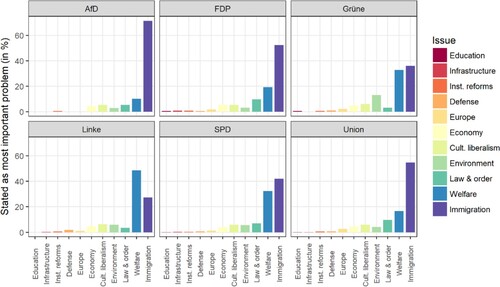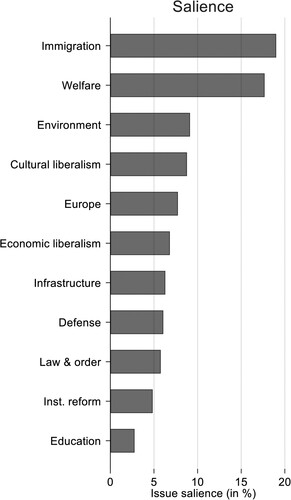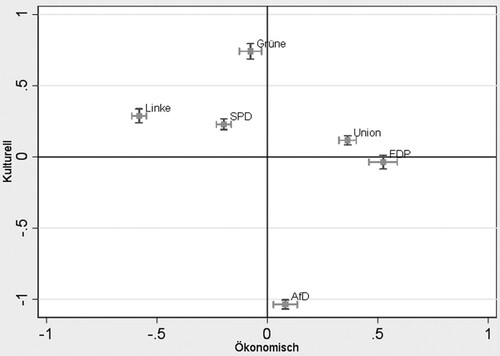Figures & data
Figure 1. The most important issues for voters in the 2017 German federal election.
Source: German Longitudinal Election Study (GLES Citation2019, ZA6803 pre-release).

Figure 2. Salience of the most important issues in the 2017 German federal election.
Note: Salience is operationalised as the percentage share of core sentences of an issue such as, for example, immigration compared to the number of all observations during an election campaign. Source: Kriesi et al. (Citation2020).

Figure 3. Positioning of parties in the political space in the 2013 and 2017 German federal elections.
Note: The two figures show the results of multidimensional scaling (MDS) whereby the salient issues of an election campaign – e.g. social welfare [welfare], economic reform [ecolib], cultural liberalism [cultlib], immigration [anti-immig], etc. – and the most important political parties – ‘union’ (CDU), ‘gr’ (Grüne), ‘rl’ (Linkspartei), ‘spd’, ‘fdp’ and ‘afd’ – are placed in relation to one another. The positional proximity of a party to an issue signals agreement with respect to the content, whereas positional distance signals corresponding rejection. Source: Kriesi et al. (Citation2020).
![Figure 3. Positioning of parties in the political space in the 2013 and 2017 German federal elections.Note: The two figures show the results of multidimensional scaling (MDS) whereby the salient issues of an election campaign – e.g. social welfare [welfare], economic reform [ecolib], cultural liberalism [cultlib], immigration [anti-immig], etc. – and the most important political parties – ‘union’ (CDU), ‘gr’ (Grüne), ‘rl’ (Linkspartei), ‘spd’, ‘fdp’ and ‘afd’ – are placed in relation to one another. The positional proximity of a party to an issue signals agreement with respect to the content, whereas positional distance signals corresponding rejection. Source: Kriesi et al. (Citation2020).](/cms/asset/85bb161d-9971-4ee9-8609-4df0a3c60b89/fgrp_a_2120610_f0003_ob.jpg)
Figure 4. Positioning of voters in the political space in the 2017 German federal election.
Note: This diagram shows a varimax-rotated, two-factor solution matrix for the principal component analysis. The horizontal axis comprises the economic conflict dimension based on the three issues ‘welfare state’, ‘government intervention’, and ‘budget finance’; the vertical axis comprises the cultural-identitarian dimension based on the two issues ‘European integration’ and ‘immigration.’ All variables are standardised. Source: German Longitudinal Election Study (GLES Citation2019, ZA6803 pre-release)

